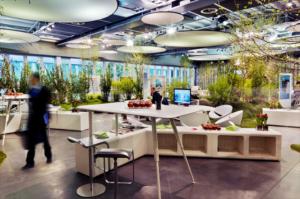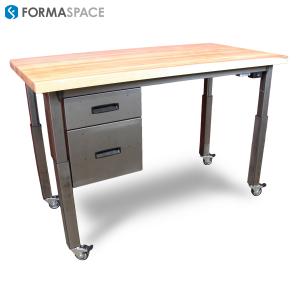Does Office Design Affect Employee Productivity?
Are you a business owner seeking to create an efficient office environment where your employees can work comfortably and productively?
Looking for ways to improve employee productivity? Improve your office space & achieve better results with this study to have in-depth knowledge of the impact of office design on employee productivity
AUSTIN, TEXAS, UNITED STATES, May 17, 2016 /EINPresswire.com/ -- Do you work in the office design arena indirectly, perhaps as an architect, contractor or designer, commercial real estate agent, space planner or office furniture dealer? In that case, you’re always on the lookout for ways to satisfy the needs of your business office clients that want to enhance their employee productivity by providing a custom, state-of-the-art office design.— Formaspace
How do you measure the impact of office design on employee productivity?
Business owners — and the office design planners supporting them — are constantly looking for ways to achieve valuable tools and get a solid return on investment. But many find that trying to evaluate their investment in office design is difficult because the valuation metrics are not as quantifiable as other productivity investments, such as software.
So today we’re going to break down the ways that office design effects employee productivity into four categories:
1.Psychological
2.Physiological
3.Inspirational
4.Transformational
in order for you to have a better understanding of how quality, ergonomic office design contributes to the bottom line.
The rise of innovative thinking as the ‘gold standard’ in employee productivity.
There is no doubt that today’s office work is vastly different compared to what was the norm back in the 1970s or 1980s. The computer revolution has swept through nearly every industry and information processing is automated like never before. Functions that existed in the past, like a typing pool or rooms dedicated to data storage in the form of giant computer tapes or hard copy binders, have fallen out of favor. Today cloud services and other online storage systems allow company employees to access information at the click of a button — or the tap of a finger on a tablet.
Wireless devices give us the freedom to work collaboratively in the office environment without having to be tied down to a specific office or cubicle. Some might see this is the logical extension of the downsizing of the traditional private office – a trend that started in the 1960s when the open office plan with cubicles debuted. High-tech companies, particularly those in software development, have gone further; many high-profile companies have abandoned cubicles all together in favor of common workspaces. As a result, the workspaces at many Silicon Valley startups look more like a coffeehouse — with a cadre of millennial information technology workers congregated around their devices as they work together in ad hoc teams.
Yet, for many companies, this trend may have peaked and has perhaps overreached. It turns out that many workers find these ad hoc open office designs — where you simply set up shop where you find space available — very unsettling and indeed counterproductive for delivering their best creative work.
And so the counterrevolution in office design has begun, led by Susan Cain, who has written a series of books about how the loud, talkative, collaborative environment, popularized in recent office designs, frustrates some of the most productive, creative people in the employer’s workforce.
https://www.youtube.com/watch?v=c0KYU2j0TM4
Cain calls this group of people ‘the introverts’ and in her books, such as the best-seller Quiet: The Power of Introverts in a World That Can’t Stop Talking, she argues that you can’t ignore the importance of establishing quiet, contemplative study spaces within the office for intense creative thinking.
And, as we know, succeeding in business today often hinges upon the creative ideas of your employee workforce. When creating your next office design, don’t assume that if it just looks creative (kitted out with de rigueur Silicon Valley startup company office accouterments like ping-pong and foosball tables), you’ll get creative results across the board. A dedicated ergonomic desk will provide the type of creative thinking space that a high traffic lounge area will not ever deliver.
So if you want your next office design to maximum employee productivity, make sure to take into account the needs of your employees who need dedicated, quiet spaces to concentrate and develop ideas.
How investments in a well-designed, ergonomic desk for each of your employees can increase employee productivity.
Now let’s move from the psychological aspects of office design and its effects on employee productivity to the importance of employee’s physiological health at the office.
Employers who keep up-to-date on the latest ergonomic research for employee well-being know that it’s critical for workers to have well-designed and well-fitted workstations and tables.
High-quality adjustable chairs can help prevent your employees from suffering from the back pain and stiffness in the shoulders, hands and fingers. Make sure that employees adjust their chairs so that their knees are just about level with their hips. Tip: Employees may need to place their feet on a foot riser or undermount shelf to achieve this.
Each office employee’s chair should have adjustable armrests, and they should sit at their workstation with their arms extended out at or below the level of their elbows.
Repetitive strain from typing, mouse movements or even cradling a telephone in the crook of your neck can lead to painful nerve problems over an extended period of time. Consider investing in headsets and software that helps automate telephone calls and uses voice recognition technology to reduce the need for typing and mousing.
As we’ve written about before, sitting all day at the office is not healthy. Make sure that employees get adequate breaks. You should also take a look at the line of Formaspace sit-to-stand, mobile workstations. These ergonomic desks allow employees to change up their physical positions throughout the day; allowing them to stand while they work during parts of the day then return to a seated position, when necessary.
These flexible workstation solutions also provide quick adjustments that allow workstations to be shared between different employees, such as during multiple shift work or job sharing.
Don’t overlook the inspirational and sociological effects that your office design can have on employee productivity (and customer sales)
It’s hard to get employees motivated when their workspace is poorly lit, worn and threadbare. Poor office conditions communicate that the businesses is either not successful or doesn’t care to invest in maintaining high standards for employees. In this kind environment, it’s difficult to demand high-performance from employees when you are not offering an up-to-date, modern high-performance workplace.
On the other hand, modern and well thought out offices can provide subtly, but important signals to your workforce that their work is important, and that where they work is a place that they are wanted and a place they want to be.
An attractive workplace with well-designed, well-fitted furniture provides a sub-conscious inspirational boost that conveys the message: “We consider where you work important, and we consider what you do at work to be important.”. During recruitment, you want this message to be clear in order to attract the best talent in the marketplace.
Don’t overlook how this same inspirational effect can inspire customers who visit your office as well. Your customers will pick up on the same signals that your employees do. If your out-of-date workplace has obviously seen better days, customers will question whether your business is successful and growing. A bright, clean and modern office environment will give the right impression and help your business grow.
If you follow our first three rules about office furniture design, your employee productivity will increase and your business is sure to grow. Now it’s time to consider transformative ways you can manage growth in your office space.
If you’ve taken our advice and provided your employees with an office environment that promotes their mental well-being, ergonomic desks that support their physiological health, and an office design that inspires them to want to come into work each day, the likely end result is your employees will be more productive and your business will grow as a result.
This brings us to our fourth point about how offices can improve employee productivity: the transformational aspect.
When you choose your office furniture supplier, make it scalable by considering to how the office furniture and space planning layouts can be altered as your business grows.
As your business grows, you may need to reconfigure your space planning several times in order to accommodate more people until you need a larger facility. With this in mind, be sure to investigate the ways that modern modular furniture systems can be reconfigured to create different floor plan layouts as you experience growing pains.
You should know that Formaspace is a leader in modular furniture design. So when you talk to one of our furniture consultants, they can explain to you how your investment is protected when you grow or need to move to new locations. Our modular furniture design means that you can easily disassemble your office furniture with simple tools, transport it easily to a new location, reassemble it, and be up and running with minimal downtime. And you can always order matching furniture components and connecting pieces to extend or expand your installation or customize it to meet your current needs.
Formaspace will help you improve employee productivity. Take advantage of our furniture expertise and insight.
Looking for ways to improve employee productivity and morale? Want to improve your office environment and achieve better results? Formaspace has the answers. Give us a call at 1.800.251.1505 and ask to speak with one of our design consultants who can get you on the right path to ultimate employee productivity.
Mehmet Atesoglu
Formaspace
8002511505
email us here


